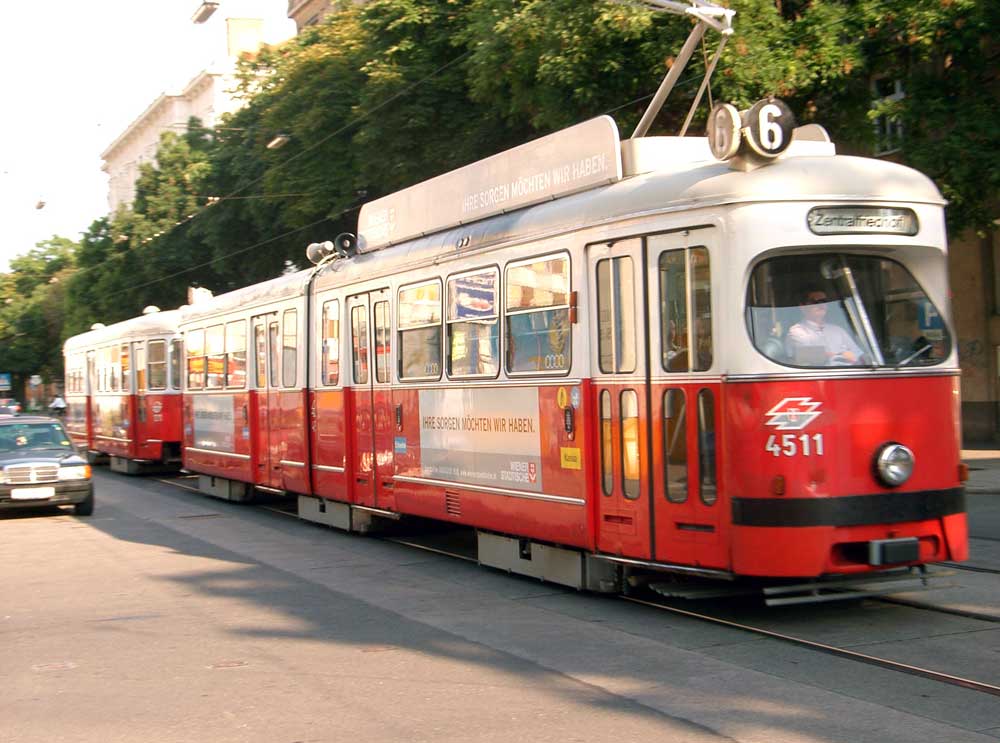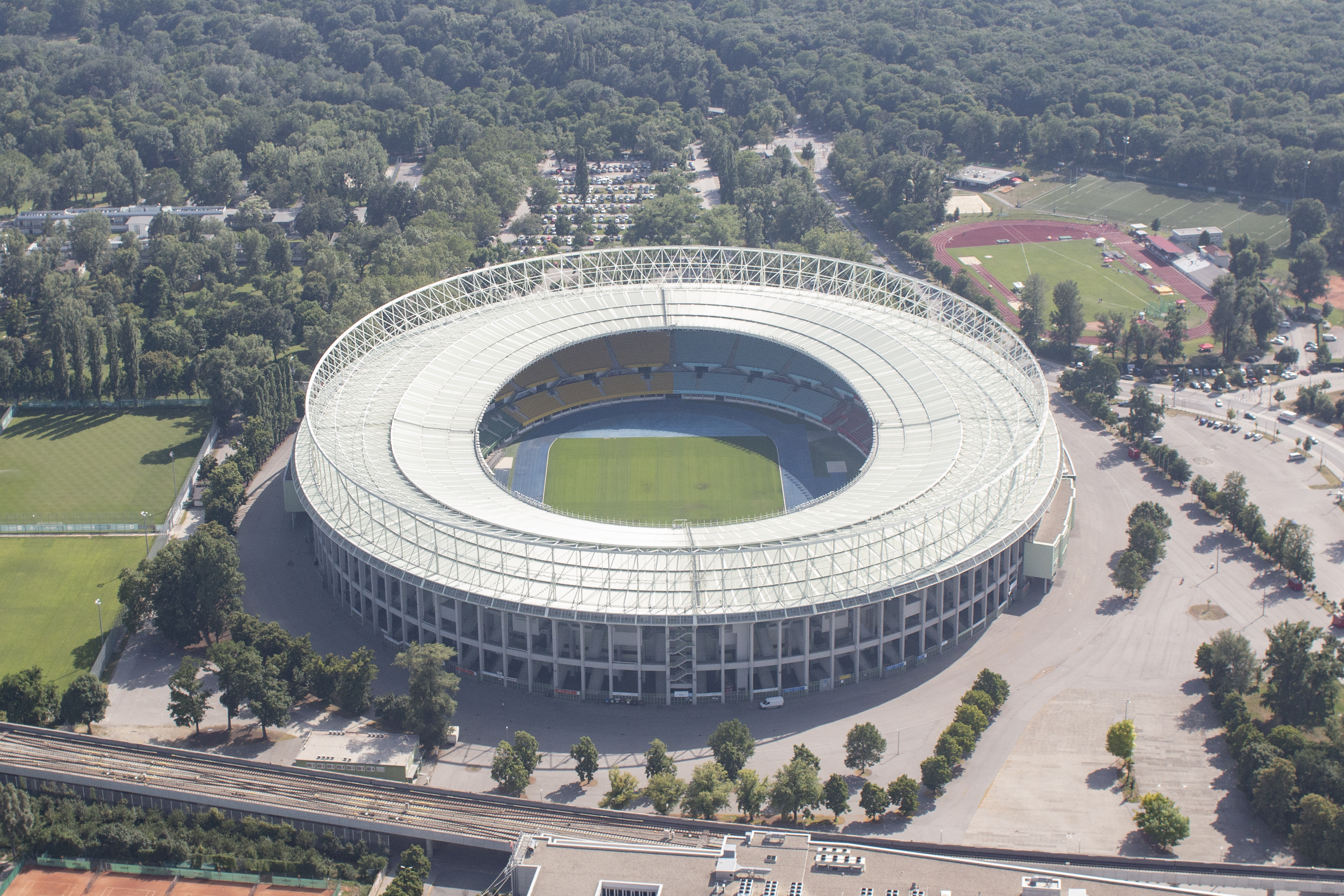|
U2 (Vienna U-Bahn)
Line U2 is a line on the Vienna U-Bahn metro system. Opened in 1980, it currently has 20 stations and a total length of , from to . It is connected to at and , at , at Karlsplatz and . Stations Line U2 currently serves the following stations: * (transfer to: ) * * (transfer to: ) * * * (transfer to: ) * * (transfer to: ) * * * * * ( park & ride facility) * (transfer to: ) * * * * * (transfer to: ) * History Construction (1963–1980) The construction of the tunnel, which was later the centrepiece of the U2, was started in 1963. After the tunnel was completed in 1966 with a length of 1.8 kilometres, it ran from Vienna Secession to Friedrich-Schmidt-Platz. Soon after, the modern construction of Vienna's railway was built on the 3 November 1969. This consisted of the newly built U1 line, and two merged lines from a tram and old metro, of the line U2 and U4 respectively. As the result of a more streamlined network, there were new routes between U1, ... [...More Info...] [...Related Items...] OR: [Wikipedia] [Google] [Baidu] |
Rapid Transit
Rapid transit or mass rapid transit (MRT), also known as heavy rail or metro, is a type of high-capacity public transport generally found in urban areas. A rapid transit system that primarily or traditionally runs below the surface may be called a subway, tube, or underground. Unlike buses or trams, rapid transit systems are railways (usually electric railway, electric) that operate on an exclusive right-of-way (transportation), right-of-way, which cannot be accessed by pedestrians or other vehicles, and which is often grade-separated in tunnels or on elevated railways. Modern services on rapid transit systems are provided on designated lines between rapid transit station, stations typically using electric multiple units on rail tracks, although some systems use guided rubber tires, magnetic levitation (''maglev''), or monorail. The stations typically have high platforms, without steps inside the trains, requiring custom-made trains in order to minimize gaps between train a ... [...More Info...] [...Related Items...] OR: [Wikipedia] [Google] [Baidu] |
Seestadt (Vienna U-Bahn)
Seestadt is a station on of the Vienna U-Bahn. It is located in Aspern in the Donaustadt Donaustadt (; literally, Danube City; Central Bavarian: ''Donaustod'') is the 22nd district of Vienna, Austria (german: 22. Bezirk, Donaustadt). Donaustadt is the eastern district of Vienna.Statistik Austria, 2007, webpage statistik.at-23450. ... District. It opened in 2013. References External links Buildings and structures in Donaustadt Railway stations opened in 2013 Vienna U-Bahn stations {{Austria-railstation-stub ... [...More Info...] [...Related Items...] OR: [Wikipedia] [Google] [Baidu] |
Siemens Modular Metro
The Siemens Modular Metro is a family of electric multiple unit trains for rapid transit systems produced by Siemens Mobility (originally Siemens Transportation Systems) and used by rail operators around the world. The vehicle concept was launched in Vienna in 2000 and is a modular concept allowing many variants of metro vehicles. Previously known as Modular Mobility, Siemens, whose rail equipment division had since been renamed Siemens Mobility, still uses the abbreviation Mo.Mo;Metro System for Bangkok, Thailand Turnkey Project Siemens 1999-07-01, |
Simmering-Graz-Pauker
Simmering-Graz-Pauker AG (SGP), founded as Simmering-Graz-Pauker AG für Maschinen-, Kessel- und Waggonbau, was an important Austrian machine and engine factory, manufacturing: machinery, boilers and rail vehicles. It was established in 1941 through the merger of Simmering machinery and rolling stock company with the Graz machine and rolling stock company and the Paukerwerkstraße Corporation from Vienna. History After World War II the company was majority owned by the state and had a wide network of international offices and subsidiaries in Asia, South America and Europe with several thousand employees. The company experienced rapid growth until the mid-1980s. SGP ceased to exist as an independent company in 1989 as part of the restructuring of the state-owned Österreichische Industrieholding (ÖIAG), when the former was renamed as ''SGP Verkehrstechnik GmbH''. In 1992, the Republic of Austria sold 26% of its shares in SGP to Siemens, and in 1993 another 48% of SGP's shares ... [...More Info...] [...Related Items...] OR: [Wikipedia] [Google] [Baidu] |
International Railway Journal
The ''International Railway Journal'' (IRJ) is a monthly international trade magazine published by Simmons-Boardman Publishing in Falmouth, England. History Founded by Robert Lewis and ''Railway Age'' editor Luther Miller as the world's first globally distributed magazine for the railway industry, the first edition of IRJ was published as a pilot in October 1960. Monthly production commenced in January 1961. Content The magazine covers a range of rail-related content, covering sectors including passenger, freight, high-speed, metro and light rail. Regular subject matters include financial news, fleet orders, infrastructure, new technologies and government policy. Circulation and Distribution IRJ publishes regular content on its website, and also publishes a monthly print edition, distributed through controlled circulation. IRJ's print edition had a circulation of 10,234 copies in 2020, according to the Audit Bureau of Circulations (UK). [...More Info...] [...Related Items...] OR: [Wikipedia] [Google] [Baidu] |
Pilgramgasse (Vienna U-Bahn)
Pilgramgasse is a station on the Vienna U-Bahn line U4. It is located in Margareten between Ramperstorffergasse and the eponymous street, which is named after Franz Anton Pilgram (1699–1761), an Austrian Baroque architect. The station is in an open cut parallel to the River Wien and curves to match the curve of the river. History The station originally opened in 1899 as part of the Vienna Valley line (''Wientallinie'') of the Vienna Stadtbahn. With the rest of the Stadtbahn network, it was closed in 1918 and reopened in 1925 after electrification. It was served by the WD (Wiental) line until the 1970s. Conversion to a U-Bahn station began on 27 October 1980. The station has two side platforms. At the Pilgramgasse end, it is accessed via the restored Otto Wagner building, which has stairs. There is access via lift at the Ramperstorffergasse end, where a new building was constructed in 1996 during a programme of renovations by Wiener Linien to improve accessibility, because t ... [...More Info...] [...Related Items...] OR: [Wikipedia] [Google] [Baidu] |
Neubaugasse (Vienna U-Bahn)
Neubaugasse is a station on of the Vienna U-Bahn. It is located in the Neubau Neubau (; Central Bavarian: ''Neibau'') is the seventh district of Vienna (german: 7. Bezirk). It is located near the center of Vienna and was established as a district in 1850, but borders changed later. Neubau is a heavily populated urban area, ... District. It opened in 1993. In this station, the two platforms are not on the same level: the platform for trains bound for is above, and the platform for trains bound for is below. References External links * Buildings and structures in Neubau Railway stations opened in 1993 Vienna U-Bahn stations {{Austria-railstation-stub ... [...More Info...] [...Related Items...] OR: [Wikipedia] [Google] [Baidu] |
Vienna S-Bahn
The Vienna S-Bahn is a suburban commuter rail network in Vienna, Austria. As opposed to the city-run urban metro network, the Vienna U-Bahn, it extends beyond the borders of the city, is operated by the ÖBB (Austrian Federal Railways), and consists of many branch lines. ''S-Bahn'' is short for ''Schnellbahn'', which can be translated as "rapid railway". Network The Vienna S-Bahn consists of a multitude of branch lines extending beyond the city boundary, most of which converge at a central route segment called the ''Stammstrecke'' ("trunk line"). While many of the individual lines run at half-hourly or hourly intervals, they are able to offer combined frequencies of only a few minutes or less along the ''Stammstrecke''. Only line S45 operates entirely within Vienna's boundaries. Unlike many S-Bahn networks in Germany, the Vienna S-Bahn is not a separate rail network. It is integrated with, and part of, the national railway system. As such, S-Bahn trains share tracks with regi ... [...More Info...] [...Related Items...] OR: [Wikipedia] [Google] [Baidu] |
Wien Matzleinsdorfer Platz Railway Station
Wien Matzleinsdorfer Platz is a commuter rail station in Favoriten, Vienna. The station is served by S-Bahn trains and regional trains that use the trunk line. The station was opened in 1969 above Matzleinsdorfer Platz. Connections are available to tram and bus services. Vienna's first moving sidewalk was opened here to connect the station to the nearby underground tram station. The station closed temporarily on the 27th March 2021 as part of the extension of the U2 underground line. The renovation works are expected to be completed in April 2022. Connections Trams *1: Prater Hauptallee - Stefan-Fadinger Platz *6: Burggasse-Stadthalle - Kaiserebersdorf *18: Burggasse-Stadthalle - Schlachthausgasse *62: Oper, Karlsplatz - Lainz, Wolkersbergerstraße * WLB: Wien Oper - Baden Baden (; ) is a historical territory in South Germany, in earlier times on both sides of the Upper Rhine but since the Napoleonic Wars only East of the Rhine. History The margraves of Baden originat ... [...More Info...] [...Related Items...] OR: [Wikipedia] [Google] [Baidu] |
Vienna U-Bahn
The Vienna U-Bahn (german: U-Bahn Wien), where ''U-Bahn'' is an abbreviation of the German term ''Untergrundbahn'' ( en, underground railway), is a rapid transit system serving Vienna, Austria. With the September 2017 opening of the , five-station extension of the U1 line, the five-line U-Bahn network consists of of route, serving 109 stations. It is the backbone of one of the best performing public transport systems worldwide according to UITP (International Association of Public Transport) in June 2009.Hödl, J: ''Das Wiener U-Bahn-Netz'', Wiener Linien, 2009. More than 1.3 million passengers rode the Vienna U-Bahn every day in 2009, and 567.6 million passengers used the U-Bahn in 2011, which declined to 428.8 million passengers in 2013. The network is undergoing expansion and rolling stock renewal. Since 1969, 200 million euros have been invested annually in the extension of the Vienna U-Bahn. The modern U-Bahn opened on 25 February 1978 (after test operations began on 8 May ... [...More Info...] [...Related Items...] OR: [Wikipedia] [Google] [Baidu] |
Ernst-Happel-Stadion
Ernst-Happel-Stadion (), known as Praterstadion until 1992, sometimes also called Wiener-Stadion, is a football stadium in Leopoldstadt, the 2nd district of Austria's capital Vienna. With 50,865 seats, it is the largest stadium in Austria. It was built between 1929 and 1931 for the second Workers' Olympiad to the design of German architect Otto Ernst Schweizer. The stadium was renamed in honour of Austrian footballer Ernst Happel following his death in 1992. The stadium hosted seven games in UEFA Euro 2008, including the final which saw Spain triumph over Germany. The stadium is owned by the City of Vienna (Municipal Department 51 – Sports of the City of Vienna). It is managed by the ''Wiener Stadthalle Betriebs und Veranstaltungsgesellschaft m.b.H.'', a subsidiary of ''Wien Holding''. It is a UEFA Category 4 stadium, and as such, it is the home of the Austria national football team. It also hosts the Viennese clubs' matches in UEFA competitions. The stadium is served by S ... [...More Info...] [...Related Items...] OR: [Wikipedia] [Google] [Baidu] |




